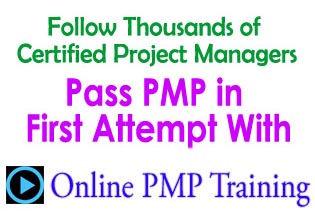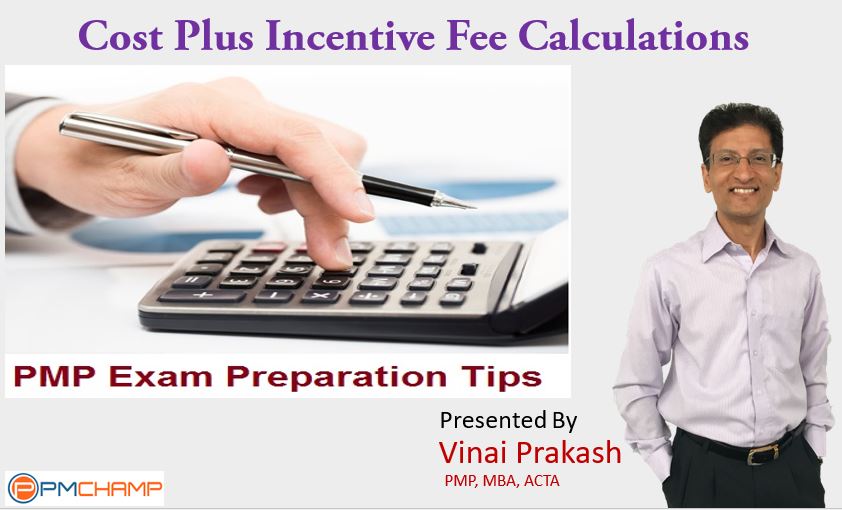One of my PMChamp PMP Coaching Workshop students, Locksley asked me an interesting question regarding contract calculations. Most questions in the PMP exam from the Procurement Management Knowledge Area are about the different types of contracts, and choosing the best type of contract in a particular situation. But this one was different…
This interesting Contract Question was however about calculations, requiring you to work out the total payment due to the Contractor (Seller), in Cost Plus or Fixed Price type of contracts.
In this post, I’ll show you how to tackle this kind of contract calculation questions for the PMP exam.
First of all, you must know what is a CPIF contract – a Cost Plus Incentive Fee contract. In the CPIF contract, the buyer contracts the seller to reimburse all the costs for the project.
But then, how does the seller make money?
Because only the Actual Cost is covered… So the Buyer agrees to pay an Incentive Fees to the Seller. Thus the name of the contract – CPIF.
However, the seller should not take undue advantage of this situation, knowing that all costs are covered (like having a blank cheque). Because the seller can become complacent, knowing that all costs are covered, and that a profit (incentive) is guaranteed.
Therefore, the Buyer sets out clear guidelines for the incentives, and a profit sharing ratio. There is a good chance of making a decent profit, and there is a penalty to finish the project later, or at a higher cost than targeted.
This incentives the Seller to:
- Keep the costs as low as possible,
- Finish the contract as early as possible,
- And generate the maximum incentive and profit.
Question: A cost-plus-incentive-fee contract has the following characteristics:
- Sharing ratio: 80/20
- Target cost: $100,000
- Target fee: $12,000
- Maximum fee: $14,000
- Minimum fee: $9,000
How much will the seller be reimbursed if the cost of performing the work is $95,000?
A)
Before we attempt this question, we need to understand the terms set in this question.
Sharing Ratio
A CPIF contract has a Sharing Ratio. A 80/20 sharing ratio means that 80% is for the buyer, and 20% is for the seller. Remember this. The ratio is always written in the Buyer:Seller Ratio format.
Target Cost
The expected cost, or the target cost of this project.
Target Fee
This is the expected fees that the seller will get. The seller is primarily working to get this fee in doing the project. Plus there is the expectation of an incentive fee…
Maximum Fee
This is the maximum incentive the Seller can expect to get, based on good performance, and the sharing ratio.
Minimum Fee
This is the minimum incentive fees the seller will get for meeting the requirements set in the contract.
Calculating the Final Incentive Fee
The final incentive fee due to the seller is calculated as:
Final Fee = ((Target cost – Actual Cost) * Seller’s sharing ratio) + Target fee
Substituting the values in the above formula, we get
Final Incentive Fee = ((
But this is just the incentive. The Seller will also get the costs paid.
Therefore, the Final Reimbursed Price = Actual cost + Final Incentive Fee
=
= $108,000
Therefore, the answer for this PMP question would be Choice C = $108,000.
Another variation of this questions is given below:
Question: Using the same data as above, what will be the reimbursement to the seller if
the cost of performing the work is $120,000?
A)
Calculating the Final Incentive Fee
Do note here that the Actual cost is $120,000, and it is ABOVE the Target Cost. Thus, the seller has exceeded the costs, and will be penalized.
The final incentive fee due to the seller is calculated as:
Final Fee = ((Target cost – Actual Cost) * Seller’s sharing ratio) + Target fee
Substituting the values in the above formula, we get
Final Incentive Fee = ((
This incentive is lower than the Minimum Fee. Thus, the
Therefore, the Final Reimbursed Price = Actual cost + Final Incentive Fee
=
= $129,000
Therefore, the answer for this PMP question would be Choice D = $129,000.
EXAM TIP: Remember to adjust the Incentive to factor the Minimum Fee and the Maximum Fees. This is precisely set in the first place, within the CPIF contract, so that the seller does not make an unduly high profit. But is incentivised to make the most of it too!
Let me know if this makes sense. Do post a comment, and share your thoughts.
If you liked this post, do Like us on Facebook, and spread the word among other PMP aspirants.
And if possible, do join the PMChamp Online PMP Coaching Program to Begin to Prepare for the PMP exam in just 6 weeks. Coaching Classes begin on Monday.
All The Best!
Cheers,
Vinai Prakash, PMP
Founder: PMChamp – Helping you prepare for the PMP Exam with Tips, Tricks, and Techniques.


makes perfect sense when you emphasize the adjustment rule which unfortunately I forgot to do in the second question. Thanks for that reminder!
This is awesum. Thanks a lot. I have these concepts clear now.
Dear Prakash
Thank you for the clear example and explanation which solved my doubt on the different incentive contracts
Thank you. These formulas were not included in my PMP prep book.
Thank you, Very informative
Thanks.. cost plus contracts are used in most of projects
the question for real world is whether customer (buyer) will be so willing to pay 120k in the first place

T&M always look good on the paper
Thank you for this detailed and easily understandable example.
This was very much required.